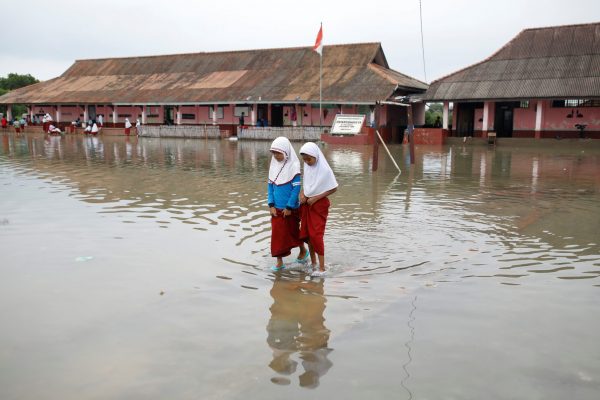Women’s empowerment activists praise these appointments, seeing them as a means of signalling to the wider populace that barriers to women taking up leadership positions are slowly being reduced. But they also note that such efforts need to be more widely applied and more pervasive to reduce gender inequality in Indonesia.
Indonesia ranked 104 out of 160 countries on the United Nations Development Programme’s 2017 gender inequality index, which measures gender disparities in education, reproductive health and economic and political participation. That ranking has changed little in recent years and is below that of most of its Asian neighbours.
While gender gaps in childhood are closing, gender gaps in adulthood are persisting. Tackling maternal mortality continues to be a major challenge, particularly given the difficulty of providing accessible birthing facilities with appropriately skilled medical staff in the many small islands throughout the archipelago.
All too often national policies and international development programs concerned with women’s empowerment mainly focus on improving the number of beneficiaries: the number of girls who go to school, the number of women who can give birth safely or who can access credit for livelihood initiatives.
These are certainly indicators of progress, but long-term reductions in gender inequality involve breaking down or transforming the economic, political and social power structures that prevent women from achieving their full potential and a higher quality of life. This will be no mean feat given Indonesia’s large population and geographic size, the number of districts with significant policymaking autonomy and the presence of diverse social norms that in some places limit the role of women in public life and decision-making.
Indonesian civil society organisations (CSOs) play a key role in chipping away at social norms and structural barriers to gender equality. They provide the crucial link between ‘high-level’ policy and concrete changes on the ground by supporting large networks of subnational women’s organisations and groups.
These bottom-up initiatives seek to improve participatory development so that women — particularly those locked out of public life or unaccustomed to participating in village-level decision-making forums — slowly grow in skill and number to collectively influence how priorities are set and how money is spent. This is increasingly important now that around 10 per cent of Indonesia’s national budget is transferred directly into village coffers, following the ratification of the 2014 Villages Law.
One organisation with a network throughout Indonesia, the Female-Headed Household Empowerment Program (PEKKA), focusses its support on households where the head is a woman. It helps to form small women’s groups that share their experiences and know-how and undertake collective economic and social activities.
PEKKA supports these groups to influence village decision-making. In one village in South Kalimantan, PEKKA women’s groups collectively pressed for village funds to be used to support the formation of a village-owned enterprise (BUMDes). While the national government also advocates for forming BUMDes, it is women’s collectives through the PEKKA network that, in several instances, have ensured that such enterprises meet women’s needs and are run by women.
Another example is the Institut KAPAL Perempuan network, which seeks to improve women’s skills and confidence in participating in village development. Participants of its Schools for Outstanding Women program take part in village decision-making forums and review and evaluate working groups and district-level planning forums. In one district in East Java, the schools have been so successful that the district government is now investing in the program so that it can reach more villages.
‘Aisyiyah — the women’s organisation affiliated with the powerful Islamic organisation Muhammadiyah — facilitates small women’s groups through its Balai Sakinah ‘Aisyiyah program. Their efforts have seen village funds used for free pap smears, mammograms and other vital health services that are otherwise inaccessible to villagers for geographic, economic or cultural reasons. In other cases, women’s groups — supported by CSOs focussed on social protection, reducing violence against women and support for migrant workers — have successfully called for village funds to be used for safe houses for victims of domestic violence, protection for migrant workers and care for the elderly.
Indonesia’s women’s organisations and their networks are also bolstered by international support. The Australia–Indonesia Partnership for Gender Equality and Women’s Empowerment provides funding assistance to core CSOs, including those mentioned above. Through this collaboration the grassroots work of CSOs has been able to continue apace, reaching some 900 villages across 27 provinces as of mid-2018, in which some 1300 women’s groups with 32,000 members have directly or indirectly benefitted.
Even so, reducing the structural barriers to gender equality is a long-term project involving slow, hard-fought gains that are not easy to count in development indicators that are often bound by program timeframes. The impact of such support may only be apparent well into the future.
While there are many examples of change, these remain few and far between, given the scale of investment in village development. Elected village officials must interpret ministerial directives, district policies and regulations and administrative frameworks that are at times overwhelming.
What lies inside or outside the rules and what village funds can be used for is not always clearly understood. Villagers worry that they may break the rules if they prioritise specific types of projects, even though the Village Law is intended to create space for villagers to decide their own priorities. Clearly articulating gender-inclusive targets for village priorities at the national level may go some way towards reducing the barriers to women’s empowerment.
Rachael Diprose is a Lecturer in Development Studies in the School of Social and Political Sciences, University of Melbourne.
This article is abridged from a version that appears in the latest issue of East Asia Forum Quarterly, ‘Investing in Women’.

